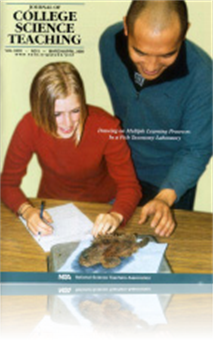All Resources
Journal Article
At Central Washington University, groups of on-campus and distance education students in an elementary science methods class interacted with each other via email to complete five cooperative reaction papers. In surveys about their views on writing pa...
Journal Article
The Case Study: Death in a Viennese Maternity Ward—Childbed Fever—A Nineteenth-Century Mystery
This case provides a brief, factual account of the pioneering work of Ignaz Semmelweis and his efforts to remedy the problem of childbed fever. The case is featured in four parts, each followed by study questions. Teaching Notes are provided....
Journal Article
One of your greatest challenges as a new teacher is learning how to engage your students. If students aren’t actively involved in the learning process, they cannot excel in the science classroom. This article presents some strategies for capturing ...
Journal Article
This paper describes some of the nuts and bolts problems associated with making the transition from traditionally taught laboratories to investigative student-centered ones. The three main areas the authors consider are: 1) What are the institutional...
Journal Article
Science classes are an appropriate place for students to examine relevant ethical problems. Nutrition science classes, in particular, discuss current scientific information as well as ethical issues, such as cultural differences, meanings attached to...
Journal Article
Science and Children’s editor shares thoughts regarding the current issue....
Journal Article
Taxonomy laboratories typically emphasize learning by rote memorization. In place of memorization, however, the authors designed a laboratory notebook exercise that employs drawing and close observation for a better educational experience. This artic...
Journal Article
Commentary: The Science of Special Education
An opinion piece about the need to improve science curricula in the area of special education....
Journal Article
Educators and scientists alike acknowledge the shortage of minorities pursuing science careers. To address this problem, West Virginia University (WVU) has created the Health Sciences and Technology Academy (HSTA), which reaches out to underrepresent...
Journal Article
To teach critical-thinking skills in introductory biology, the authors selected an immersion system using analysis problems that incorporates critical thinking into a specific discipline rather than presenting it as an isolated topic. Analysis proble...
Journal Article
The Idea Bank provides tips and techniques for creative teaching, in about 1,000 words. This month’s Idea Bank includes an analogy for understanding electron configurations, information on electronic mailing lists, along with a listing of some usef...






